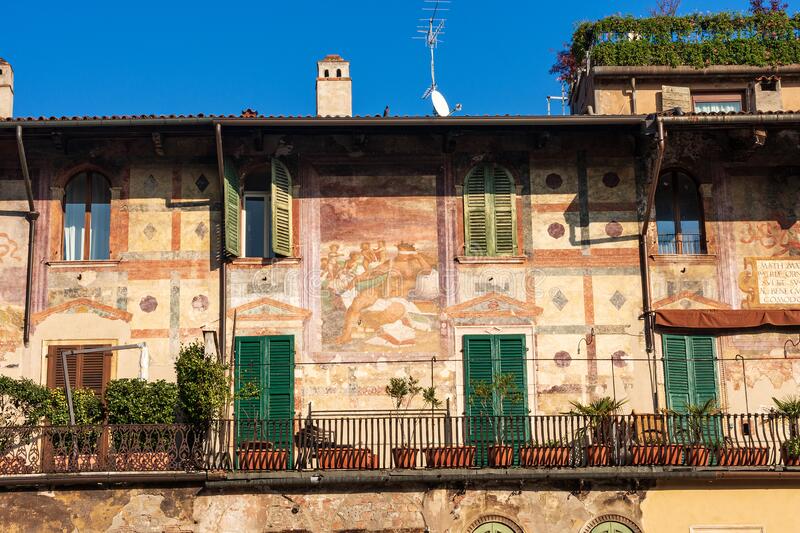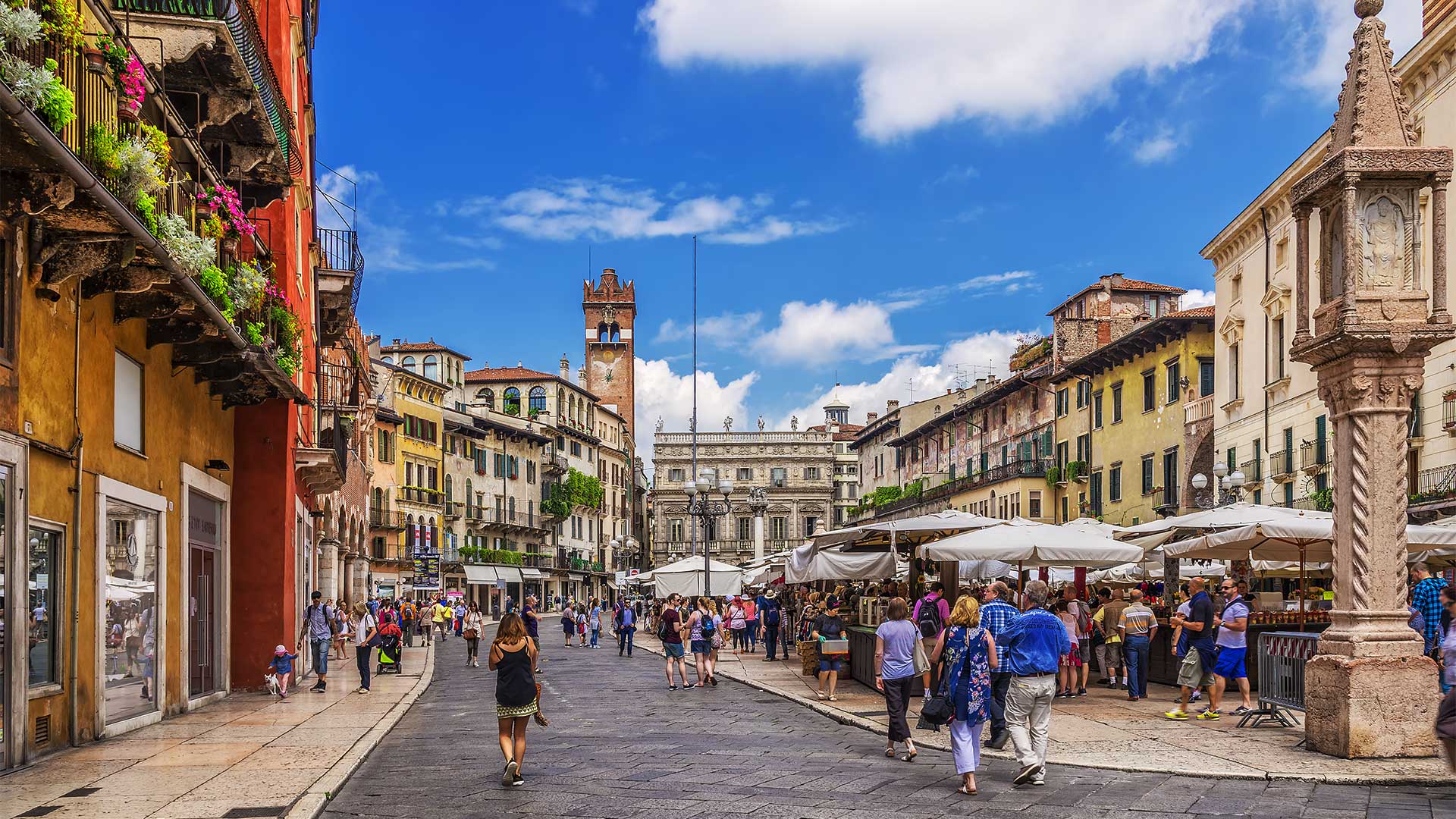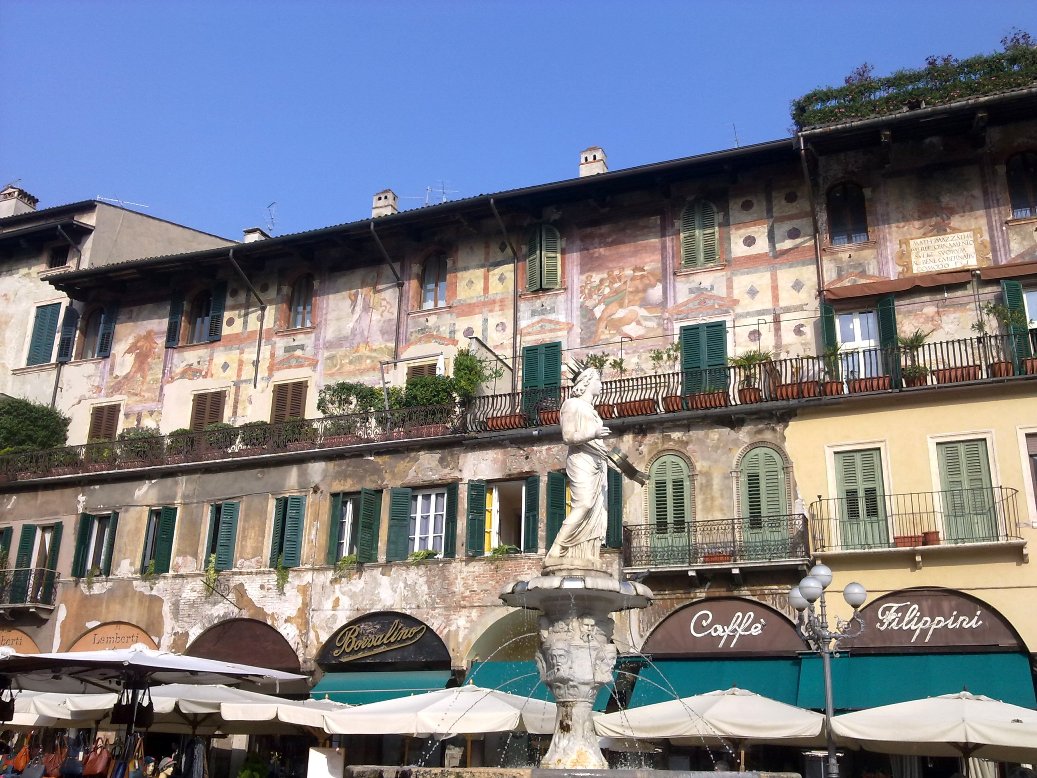History of the Mazzanti Houses
The expression “Case Mazzanti” refers to a vast 14th-century building complex that characterises in a picturesque way one of the most beautiful squares in Italy: Piazza delle Erbe.

Piazza delle Erbe
Piazza delle Erbe was the centre of business throughout the Middle Ages and the Modern Age, up until the present days. The profile of this square has constantly evolved according to the economic and, to some extent, political ferment that has characterised its history.
Various activities, exchange and loan banks, markets of fodder, meat, and other handmade products both agricultural and not, were based here. The square was redeveloped under the Scaligers: particularly important was the construction of the Gardello Tower and the Mazzanti
Houses in 1370.
This square stands where once stood the Roman Forum, recalled by the Rhythm of the Anonymous Pipinian.
Where the Mazzanti Houses can now be seen, there was once a Roman
building mentioned by Canobbio in the 16th century: “On the other side, where the apothecary shops are, many antiquities of columns and more
have been found, and many can also be seen in the cellars in work”.
History of the Building

During the period of the Scaliger Seigniory, the area of Piazza delle Erbe - the ancient Forum - saw its redevelopment as a business centre thanks to the redesign of the square, which was achieved through the addition of new constructions (or reconstructions) of pre-existing buildings; these included the Scaliger house known as the Mazzanti House, whose construction took place where once stood the Roman building , which had probably been abandoned or destroyed in the 1117 earthquake.
The Roman palace, formerly owned by the Scaligers, appears to have been rebuilt by Alberto della Scala, who ruled from 1277 to 1301, as was the well placed at the beginning of Volto Barbaro, in the area behind the building.
The rooms on the ground floor belonged to various private citizens, while the upper floors were owned by the Scaligers, who used them as their grain warehouse.
The market in Piazza delle Erbe (Scaliger Age)

In the Scaliger period, the market in Piazza delle Erbe had a well-organised structure. On the north side (where Maffei Palace is now located) were the tables of the money changers; on Corso Santa Anastasia, bina aurificum, were the goldsmiths workshops; instead, in the square (between the street and the Costa), on the ground floor of the houses that later belonged to the Mazzanti, were the apothecaries and haberdashers shops.
At the back of these dwellings stood the sellers of pinion clothes; on the other side of the square, on the other hand, stood the cloth merchants, who then moved into the Sgarzarie (carding rooms). Workshops and sales counters surrounded all the sides of the houses, namely: part of the bina marcarorum (on the square), the bina aurificum (Corso Sant'Anastasia), the bina pignolatorum (Via Scala dei Mazzanti), and the bina centonariorum (Vicolo Barbaro). On Via Scala Mazzanti were the staciones of the pinion clothes; on the square, on the other hand, there were those of the merchants and apothecaries.
From Giovanni Gonzaga to Matteo Mazzanti
In 1511 the Mazzanti Houses were given by the Emperor to his lieutenant in Verona, Giovanni Gonzaga. The original deed of sale between the Mazzanti and the Gonzagas has never been found: there is a precise mention of an amnesty drawn up on 5 May 1517 between the Mazzanti and the Republic of Venice, which in the meantime had regained possession of Verona.
The document refers to the fact that in March 1511, Matteo Mazzanti, on behalf of himself and his brothers, had purchased from the illustrious Giovanni Gonzaga a granary partly covered and partly uncovered that stood above the apothecaries' and other people's workshops.
This granary was located in Verona, in the district of Santa Maria Antica. On one side, it was adjacent to the Domus Nova (House of the Podestà and residence of the judges), on a second side to Corso Santa Anastasia, on a third side to the large market square, and on a fourth side to Via dei Pignolati, along a perimeter of 28 perches.
The Mazzanti family
The author of the Mazzanti family's fortunes was Ludovico Mazzanti, who originated from Ferrara and who first lived in contrada Santo Stefano and then in contrada San Sebastiano. By the mid 14th century he was the manager of several apothecary shops in Piazza delle Erbe, namely those at the sign del Medico, della Colomba, and del Leone. Ludovico had many children, but among them the one who distinguished himself in his ability to preserve the family business was Matteo: he inherited his father's business and bought and decorated the house.
Ludovico Mazzanti ran several apothecary shops in Piazza delle Erbe and had many children: Giorgio, Matteo, Francesco, Battista, Giacoma, and Agostino. Many of the city's apothecary shops were located on the ground floor of the Mazzanti Houses: those under the sign of the Angel, the Dove, the Donkey, and the Lion belonged to the Mazzanti Family.
The lion also became the coat of arms that the Mazzanti family used for their chapel: here is depicted the rampant lion.
The structure of the Building

The Mazzanti Houses overlook Piazza delle Erbe and Vicolo Mazzanti. The front is the one that overlooks Piazza delle Erbe, and is very articulated architecturally. Observing it, it is possible to notice the two 'wings' that compose it: a lower one and a higher one.
The lower structure (towards the Lamberti Tower) consists of a loggia on the ground floor, made up of 15 unequal and lowered arches. These arches are supported by 16 Renaissance columns which are different in height and capitals. On these columns it is possible to admire the coats of arms of various families.
The second floor of the loggia was heavily modified in the 19th century with the addition of stone balconies and uneven openings. The façade as a whole consists of four floors and a mezzanine between the ground and the first floors.
Frescoes

The uniqueness and prestige of the Mazzanti Houses derive from the luxurious and precious frescoes that adorn the side overlooking Piazza delle Erbe. The custom of painting the exterior façades of noble houses and palaces has ancient origins and became a custom in Verona during the Renaissance. In the wake of this artistic and cultural trend, Verona earned the nickname 'Urbs Picta', or painted city.
The initial decoration of the building took place before the Mazzanti family took over and was followed by the more substantial decoration desired by Matteo Mazzanti. Matteo Mazzanti turned to the painter Alberto Cavalli. On the walls, already frescoed with fake architecture, the Mantuan painter added the Allegories of Ignorance, Prudence, and Envy; on the corner structure he added those of the Struggle between Giants and Providence, to which was added, towards Corso Santa Anastasia, a Laocoon.
Alberto Cavalli
There is little information on Alberto Cavalli: he originated from Sabbioneta and was a pupil of Giulio Romano: 'in his majestic and daring manner, he approached that great master more than anyone had before'. It is reasonable to wonder if the Mantuan Alberto Cavalli who painted the façade of the Mazzanti Houses was the Alberto Cavalli of Sabbioneta. From the similarity in stroke and style, it is possible to say that it is the same person.
During the 16th century he was active in Savona and Mantua. In 1584 he was called to Sabbioneta, during the period of Vespasiano Gonzaga Colonna, to decorate the Hall of the Ancestors in the Ducal Palace. In Sabbioneta, Cavalli can also be found in the Sala di Marte (Mars Room) and the Sala di Enea (Aeneas Room) of Palazzo del Giardino.
The Mazzanti Houses from 1800 to the present days
The Mazzanti Houses hosted numerous workshops on the ground floor until the mid-19th century. The history of these activities can be traced - in part - through the Interprete Veronese, a Veronese guide of the time.
In 1800, the Mazzanti Houses were numbered 1056, 1057, 1058, and 1059. Between 1828 and 1844, the ground floor spaces of the Mazzanti Houses hosted merchants, gold and silver beaters, goldsmiths, haberdashers, money changers, and traders.
In the early 1900s, the building - now occupied by the 'Casa Mazzanti' bar and restaurant - was bought by the Ruffo family. For years, this space was used as a leather tannery: it was converted into a cafeteria only around 1950.
